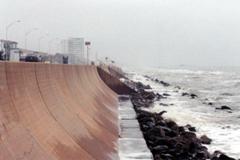Galveston Island Sinking Faster Than Previously Thought
 Galveston Island is sinking at an alarming rate, probably as much as two feet per century, the Houston Chronicle reported recently. Recent readings at a tide gauge show that the water level has risen more than a foot over the last 50 years. Galveston Island is located along the Texas gulf coast, southeast of Houston. The island is home to about 60,000 residents.
Galveston Island is sinking at an alarming rate, probably as much as two feet per century, the Houston Chronicle reported recently. Recent readings at a tide gauge show that the water level has risen more than a foot over the last 50 years. Galveston Island is located along the Texas gulf coast, southeast of Houston. The island is home to about 60,000 residents.Cause
Scientists say much of the sea level rise can be traced to three factors:
- Subsidence. Primarily from oil and gas extraction.
- Compaction. Sediments thousands of feet below ground are pressed down.
- Faulting. It is believed that the coastal areas are slowly are sliding toward the Gulf of Mexico Basin.
Most estimates say that Galveston Island will sink another two feet over the coming century. If true, the effect could be disastrous, as the Chronicle reports:
The National Hurricane Center recently mapped the effects of a Category 1 hurricane striking the island, moving west-northwest at 5 mph. At its present elevation the entire island, except for the far west end, remained dry.However, with a 2-foot drop in elevation, nearly the entire island, except for the highest areas behind the seawall, was submerged.
A few years ago scientists with the Environmental Protection Agency simulated the effects of a 2-foot rise in sea level. At high tide, the agency found, a majority of Galveston was under water.
If the island sinks 2 more feet and the waters rise 2 feet this century, most of the island would be uninhabitable.
Solutions
Currently the only effort to protect the island is sand replenishment, where sand is transported from offshore to the coast. In 2007, Texas will receive $240 million from the federal government for rebuilding its coast. Much of the money will be spent on sand replenishment. Other solutions are less popular. A temporary fix might be to prohibit new building within 100 feet of the protective sand dunes. But that would hamper development, especially in the booming west end. Another would be to end the federal flood insurance program that pays to rebuild damaged homes. No one honestly believes that will happen anytime soon.
In 1900, Galveston Island was struck with no warning by a hurricane. That storm, which killed at least 8,000 is still the worst natural disaster in U.S. History. This time the warning signs are abundant. It remains to be seen if they will be heeded.




<< Home